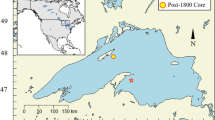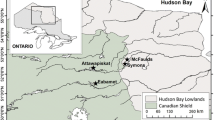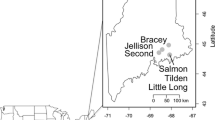Abstract
A 39-cm sediment core from Castle Lake, California (USA) spans the last ~ 450 years and was analyzed for diatoms and organic geochemistry (δ15N, δ13C, and C:N), with the goal of determining sensitivity to natural climate variation and twentieth century anthropogenic effects. Castle Lake is a subalpine, nitrogen-limited lake with ~ 5 months of annual ice cover. Human impacts include light recreational use, past fish stocking, and experimental use by the Castle Lake Research Station. The base of the core (below 32 cm; pre mid-1700s) represents the period of maximum ice cover. In contrast, the end of the Little Ice Age (mid 1700s–early 1800s) is dominated by cyclotelloids (mostly Discostella stelligera), indicating significant open-water periods, a condition that persisted into the early 1900s. Cyclotelloids began to decline in the 1960s and were replaced by the Fragilaria tenera grp. (peak in 1970s), succeeded by Asterionella formosa (peak ~ 2010), and accompanied by a reduction in δ15N values and a decrease in C:N that may represent increased atmospheric nitrogen deposition. Another anthropogenic signal was discerned in the core and was interpreted to be the result of an ammonium nitrate fertilization experiment of the epilimnion that was conducted in 1980 and 1981. This signal was manifested in the core largely by a negative excursion in δ15N, possibly caused by fractionation during denitrification in surface sediment. A phytoplankton monitoring dataset collected by the Castle Lake Research Station from 1967 to 1984 corroborates the timing of increased araphid euplanktonic species in the 1970s, and increases in two benthic diatoms (Staurosirella pinnata and Tabellaria fenestrata), entrained in the phytoplankton tows during the experimentation years. Both ice cover and nitrogen addition appear to be strong drivers that affected the lake diatoms, although additional drivers, such as fish stocking and associated cascade effects need further exploration. These data will be helpful for interpreting longer core records from Castle Lake, should the opportunity arise, as well as cores from similar systems in the region.







Similar content being viewed by others
References
Appleby PG, Richardson N, Nolan PJ (1991) 241Am dating of lake sediments. Hydrobiologia 214:35–42
Aquino-López MA, Blaauw M, Christen JA, Sanderson NK (2018) Bayesian analysis of 210Pb dating. J Agric Biol Environ Stat 23:317–333
Axler R, Reuter J, Priscu J, Loeb S, Carlton R, Goldman ZJ, C, (1984) Transformations of nitrogen following epilimnetic N-fertilization in Castle Lake, CA.: 2. nitrate and ammonium depletion pathways. Verh Internat Verein Limnol 22:583–583
Axler R, Reuter J (1996) Nitrogen uptake by phytoplankton and periphyton: whole-lake enrichments and mesocosm-15N experiments in an oligotrophic lake. Limnol Oceanogr 41:659–671
Bachmann RW, Goldman CR (1965) Hypolimnetic heating in Castle Lake, California. Limnolo Oceanogr 10:233–239
Baskaran M, Naidu AS (1995) 210Pb-derived chronology and the fluxes of 210Pb and 137Cs isotopes into continental shelf sediments, East Chukchi Sea, Alaskan Arctic. Geochim et Cosmochim Acta 59:4435–4448
Battarbee RW (1986) Handbook of holocene palaeoecology and palaeohydrology. In: Berglund BE (ed) Diatom analysis. Wiley, New York, pp 527–570
Binford MW, Kahl JS, Norton SA (1993) Interpretation of 210Pb profiles and verification of the CRS dating model in PIRLA project lake sediment cores. J Paleolimnol 9:275–296
Birks HJB (2012) Overview of numerical methods in paleolimnology. In: Birks HJB, Lotter AF, Juggins S, Smol JP (eds) Tracking environmental change using lake sediments. Springer, Netherlands, pp 19–92
Blaauw M, Christian JA (2011) Flexible paleoclimate age-depth models using an autoregressive gamma process. Bayesian Anal 6:457–474
Bowerman ND, Clark DH (2011) Holocene glaciations of the central Sierra Nevada, California. Quat Sci Rev 30:1067–1085
Cantonati M, Kelley MG, Lange-Bertalot M (2017) Freshwater benthic diatoms of central Europe. Koeltz Botanical Books, Oberreifenberg, p 942
Carpenter SR, Kitchell JF (1993) The trophic cascade in lakes. Cambridge University Press, Cambridge, p 399
Cutshall NH, Larsen IL, Olsen CR (1983) Direct analysis of 210Pb in sediment samples: self-absorption corrections. Nucl Instr Meth 306:309–312
Davis RB, Hess CT, Norton SA, Hanson DW, Hoagland KD, Anderson DS (1984) 137Cs and 210Pb dating of sediments from soft-water lakes in New England (U.S.A.) and Scandinavia, a failure of 137Cs dating. Chem Geol 44:151–185
Drake DC, Naiman RJ (2000) An evaluation of restoration efforts in fishless lakes stocked with exotic trout. Conserv Biol 14:1807–1820
Elser JJ, Luecke C, Brett MT, Goldman CR (1995) Effects of food web compensation after manipulation of rainbow trout in an oligotrophic lake. Ecology 76:52–69
Enache MD, Paterson AM, Cumming BF (2011) Changes in diatom assemblages since pre-industrial times in 40 lakes from the Experimental Lakes Area (northwestern Ontario, Canada). J Paleolimnol 46:1–15
Fenn ME, Allen EB, Weiss SB, Jovan S, Geiser LH, Tonnesen GS, Johnson RF, Rao LE, Gimeno BS, Yuan F, Meixner T, Bytnerowicz A (2010) Nitrogen critical loads and management alternatives for N-impacted ecosystems in California. Jo Environ Manag 91:2404–2423
Francey RJ, Alliso CE, Etheridge DM, Trudinger CM, Enting IG, Leuenberger M, Langenfelds RL, Michel E, Steele LP (1999) A 1000-year high precision record of δ13C in atmospheric CO2. Tellus 51B:170–193
Fuller CC, van Geen A, Baskaran M, Anima R (1999) Sediment chronology in San Francisco Bay defined by 210Pb, 234Th, 137Cs, and 239, 240Pu. Mar Chem 64:7–27
Goldman CR, De Amezaga E (1984) Primary productivity and precipitation at Castle Lake and Lake Tahoe during twenty-four years, 1959–1982. Int Ver Theor Angew Limnol Verh 22(59):1–599
Griffiths K, Michelutti N, Sugar M, Douglas MSV, Smol J (2017) Ice-cover is the principal driver of ecological change in High Arctic lakes and ponds. PLoS ONE 12:e0172989
Hadley KR, Paterson AM, Hall RI, Smol JP (2013) Effects of multiple stressors on lakes in south-central Ontario: 15 years of change in lakewater chemistry and sedimentary diatom assemblages. Aquat Sci 75:349–360
Heard AM, Sickman JO, Rose NL, Bennett DM, Lucero DM, Melack JM, Curtis JH (2014) Twentieth century atmospheric deposition and acidification trends in lakes of the Sierra Nevada, California, USA. Environ Sci Technol 48:10054–10061
Hobbs WO, Telford RJ, Birks HJB, Saros JE, Hazewinkel RRO, Perren BB, Saulnier-Talbot É, Wolfe AP (2010) Quantifying recent ecological changes in remote lakes of North America and Greenland using sediment diatom assemblages. PLoS ONE 5:1–12
Hundey EJ, Moser KA, Longstaffe FJ, Michelutti N, Hladyniuk R (2014) Recent changes in production in oligotrophic Uinta Mountain lakes, Utah, identified using paleolimnology. Limnol Oceanogr 59:1987–2001
Jassby AD, Powell TM, Goldman CR (1990) Interannual fluctuations in primary production: direct physical effects and the trophic cascate at Castle Lake, California. Limnol Oceanogr 35:1021–1038
Jassby AD, Goldman CR (1974) A quantitative measure of succession rate and its application to the phytoplankton of lakes. Am Nat 108:688–693
Johnson BE, Noble PJ, Trowbridge W, Chandra S, and Heyvaert AC (2011) Step-wise shift from cyclotelloid- to araphid-dominate diatom community in Castle Lake, Siskiyou county, CA and potential causes. Diatoms of the crown of the continent, NADS; North American diatom symposium. 16 Sep 2011
Johnson BE, Noble PJ, Heyvaert AC, Chandra S, Karlin R (2017) Anthropogenic and climatic influences on the diatom flora within the fallen leaf lake watershed, lake Tahoe Basin, California over the last millennium. J Paleolimnol 59:159–173
Juggins S (2017) Rioja: analysis of quaternary science data, R package version (0.9-15.1) https://cran.r-project.org/package=rioja
Keeling CD (1979) The Suess Effect: 13carbon-14carbon interrelations. Environ Int 2:229–300
Kornexl BE, Gehre M, Höfling R, Werner RA (1999) On-line δ18O measurement of organic and inorganic substances. Rapid Commun Mass Sp 13:1685–1693
Long ES, Sweitzer RA, Diefenbach DR, Ben-David M (2005) Controlling for anthropogenically induced atmospheric variation in stable carbon isotope studies. Oecologia 146:148–156
Mann ME (2002) Little ice age. In: MacCracken MC, Perry JS (eds) Encyclopedia of global environmental change, pp 504–509
Mann ME, Zhang A, Rutherford S, Bradley RS, Hughes MK, Shindell D, Ammann C, Faluvegi G, Ni F (2009) Global signatures and dynamical origins of the Little Ice Age and Medieval Climate Anomaly. Science 326:1256–1260
Matthes F (1939) Report of committee on glaciers. Eos Trans AGU 20:518–523
Matisoff G (2017) Activities and geochronology of 137Cs in lake sediments resulting from sediment resuspension. J Environ Radioact 167:222–234
Maxwell TM, Silva LCR, Horwath WR (2018) Integrating effects of species composition and soil properties to predict shifts in montane forest carbon water relations. Proc Natl Acad Sci USA 18:E4219–E4226
Mejica BN (2014) Terrestrial-aquatic linkages: watershed (geologic and vegetation) runoff influences on primary production of a sub Alpine Lake. M.S. thesis University of Nevada Reno, p 111
Meyers PA, Lallier-Vergès E (1999) Lacustrine sedimentary organic matter records of late quaternary paleoclimates. J Paleolimol 21:345–372
Neukom R, Steiger N, Gómez-Navarro JJ, Wang J, Werner JP (2019) No evidence for globally coherent warm and cold periods over the preindustrial common era. Nature 571:550–554
Noble PJ, Chandra S, Kreamer DK (2013) Dynamics of phytoplankton distribution in relation to stratification and winter precipitation, Fallen Leaf Lake, California. West N Am Nat 73:302–322
Pitman KJ, Smith DJ (2012) Tree-ring derived Little Ice Age temperature trends from the central British Columbia Coast Mountains, Canada. Quat Res 78:417–426
Priscu JC, Goldman CR (1983) Seasonal dynamics of the deeo-chlorophyll maximum in Castle Lake, California. Can J Fish Aquat Sci 40:208–214
Renberg I, Hansson H (2008) The HTH sediment corer. J Paleolimnol 40:655–659
Rühland KM, Paterson AM, Hargan K, Jenkin A, Clark BJ, Smol JP (2010) Reorganization of algal communities in the Lake of the Woods (Ontario, Canada) in response to turn of-the-century damming and recent warming. Limnol Oceanogr 55:2433–2451
Rühland KM, Paterson AM, Keller W, Michelutti N, Smol JP (2013) Global warming triggers the loss of a key Arctic refugium. Proc R Soc B 280:20131887
Rühland K, Paterson AM, Smol JP (2015) Lake diatom responses to warming: reviewing the evidence. J Paleolimnol 54:1–35
Saros JE, Michel TJ, Interlandi SJ, Wolfe AP (2005) Resource requirements of Asterionella formosa and Fragilaria crotonensis in oligotrophic alpine lakes: implications for recent phytoplankton community reorganizations. Can J Fish Aquat Sci 62:1681–1689
Saros JE, Clow DW, Blett T, Wolfe AP (2011) Critical nitrogen deposition loads in high-elevation lakes of the western US inferred from paleolimnological records. Wat Air Soil Poll 216:193–202
Sheibley RW, Enache M, Swarzenski PW, Moran PW, Foreman JR (2014) Nitrogen deposition effects on diatom communities in lakes from three national parks in Washington State. Water Air Soil Pollut 225:1857
Sickman JO, Bennett DM, Lucero DM, Whitmore TJ, Kenney WF (2013) Diatom-inference models for acid neutralizing capacity and nitrate based on 41 calibration lakes in the Sierra Nevada, California USA. J Paleolimnol 50:159–174
Sienkiewicz E, Gsiorowski M (2016) The effect of fish stocking on mountain lake plankton communities identified using palaeobiological analyses of bottom sediment cores. J Paleolimnol 55(2):129–150
Stratton JJ, Ham J, Collett JL Jr, Benedict K, Borch T (2019) Assessing the efficacy of nitrogen isotopes to distinguish Colorodo Front Range ammonia sources affecting Rocky Mountain National Park. Atmos Environ 215:116881
Suttle CA, Stockner JG, Harrison PJ (1987) Effects of nutrient pulses on community structure and cell size of a freshwater phytoplankton assemblage in culture. Can J Fish Aquat Sci 44:1768–1774
Tiberti R, von Hardenberg A, Bogliani G (2014) Ecological impact of introduced fish in high altitude lakes: a case of study from the European Alps. Hydrobiologia 724:1–19
Van Metre PC, Fuller CC (2009) Dual-core mass-balance approach for evaluating mercury and 210Pb atmospheric fallout and focusing to lakes. Environ Sci Technol 43:26–32
Viau AE, Ladd M, Gajewski K (2012) The climate of North America during the past 2000 years reconstructed from pollen data. Global Planet Change 84–85:75–83
Wang J, Baskaran M, Nierdermiller J (2017) Mobility of 137Cs in freshwater lakes: a mass balance and diffusion study of Lake St. Clair, southeast Michigan. Geochim Cosmochim Acta 218:323–342
Wiltse B, Paterson AM, Findlay DL, Cumming BF (2016) Seasonal and decadal patterns in Discostella (Bacillariophyceae) species from bi-weekly records of two boreal lakes (Experimental Lakes Area, Ontario, Canada). J Phycol 52:817–826
Winberg MR, Garcia RS (1995) National low-level waste management program radionuclide report series volume 14: Americium-241. national low-level waste management program, Idaho National Engineering Laboratory, Lockheed Idaho Technologies Company, Idaho Falls, Idaho. p 20
Wolfe AP, Baron JS, Cornett RJ (2001) Anthropogenic nitrogen deposition induces rapid ecological changes in alpine lakes of the Colorado front range (USA). J Paleolimnol 25:1–7
Wolfe AP, Van Gorp A, Baron JS (2003) Recent ecological and biogeochemical changes in alpine lakes of Rocky Mountain National Park (Colorado, USA): a response to anthropogenic nitrogen deposition. Geobiol 1:153–168
Yamamuro M, Kayanne H (1995) Rapid direct determination of organic carbon and nitrogen in carbonate-bearing sediments with a Yanaco MT-5 CHN analyzer. Limnol Oceanogr 40:1001–1005
Acknowledgements
This work was supported by funds from the University of Nevada College of Science, Office of Research and Innovation, and Undergraduate Research. Thanks to B. Johnson and A. Heyvaert for their work on the 2009 core, M. Brannigan, and G. Binda for field assistance, and C. Goldman and many support staff from Castle Lake Research Station for access to monitoring datasets. We thank Lesleigh Anderson (US Geological Survey) and two anonymous reviewers who provided additional insight and improvements that greatly benefited the final manuscript. Any use of trade, firm, or product names is for descriptive purposes only and does not imply endorsement by the US Government.
Author information
Authors and Affiliations
Corresponding author
Additional information
Publisher's Note
Springer Nature remains neutral with regard to jurisdictional claims in published maps and institutional affiliations.
Electronic supplementary material
Below is the link to the electronic supplementary material.
10933_2020_160_MOESM4_ESM.xlsx
Table S4 Spreadsheet monitoring data from Castle Lake, including summaries of phytoplankton from 1968–1984, with a focus on diatom fraction, seasonal and depth variability for 1968–69, and ice-out dates from 1964-2013 (XLSX 750 kb)
Rights and permissions
About this article
Cite this article
Noble, P.J., McGaughey, G.A., Rosen, M.R. et al. A 450-year record of environmental change from Castle Lake, California (USA), inferred from diatoms and organic geochemistry. J Paleolimnol 65, 201–217 (2021). https://doi.org/10.1007/s10933-020-00160-y
Received:
Accepted:
Published:
Issue Date:
DOI: https://doi.org/10.1007/s10933-020-00160-y




